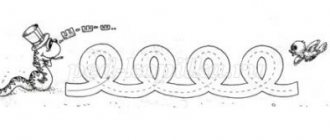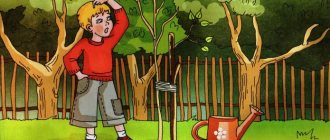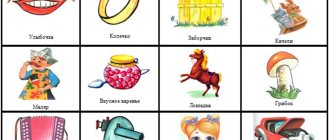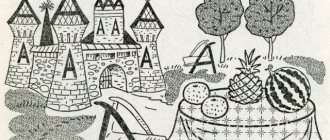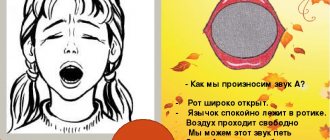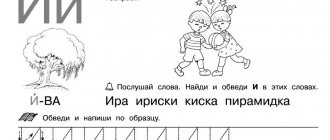We put the sounds [L], [L']
To set the sounds [L], [L'], use the exercises “Needle”, “Painter”, “Turkey Poults”, “Steps”, “Ladle”, “Hunter”.
If the sound [L] is absent in the child’s speech, it is placed in 2 stages:
- Interdental production of sound, when the child is asked to say the combination of sounds “ya”. When pronouncing the sound “y”, you need to pronounce it briefly, straining the articulatory apparatus. Next, pronunciation is carried out by squeezing the tongue between clenched teeth. Repeat the exercise until the clarity of the sound is established - you need to establish the position of the jaw in which it was possible to reproduce the sound.
- Dental production of sound - the tongue is moved to a position behind the teeth, it is pressed firmly to the alveoli, and they pronounce “ly-ly-ly.”
It is important to develop the correct direction of the air stream. If a child has several sounds in interdental pronunciation, it is worth developing motor skills of the tip of the tongue. You can help with this in any convenient mechanical way.
If a child replaces the sound [L] with the sound [Y], he is asked to place a round tube on the middle part of the side of the tongue, with his mouth open, and the tip of the tongue should be tucked behind the upper incisors. The main difficulty is that the child continues to hear the sound that he played earlier. Therefore, it is important to connect the baby’s auditory attention to the sound that he pronounces during its production.
The importance of making a whistling sound
If it is noticed that the child pronounces the whistling sound incorrectly, the speech therapist will highlight the nature of the problem, it could be:
- sigmatism - distortion of [C] and [Cb] occurs;
- parasigmatism - substitution of [С] and [Сь] with other sounds (forelingual or hissing).
Setting the sound [C] will help avoid problems in writing and reading:
- Dysgraphia is a disorder in which basic errors are made when writing.
A person replaces letters with phonetically similar sounds, for example:
name => savut
white => ripe
Fluff => Pooh
- Dyslexia is a reading disorder in which a person repeats the same mistakes when reading. Sounds are mixed or replaced by others, spelling, difficulty understanding what is read.
It is difficult for a person to combine letters into syllables, and syllables into words. This leads either to misunderstanding of what is read or to distortion of information.
- Dyslalia is a violation of the pronunciation of sounds. The diagnosis is made after 4–5 years; until this time, such pronunciation is considered normal and goes away on its own.
Teaching children
Federal State Educational Standard
- Federal State Educational Standard for Preschool Education
- Preparation for school
- Fear of homework
- Problems at school for children
- The task of educators in preparing children for school
- Preparing for school in kindergarten
- Preparing for school in development centers
- What's happened ?
- What should a child be able to do for school?
- Preschool education
Children
- ABC and alphabet
- Alphabet for children
- ABC by syllables
- Russian alphabet for children
- Development of fine motor skills in children
- Introducing children to books
- Alphabet from diapers
- English for children
- Early development methods
- Sensory development of children
- The Maria Montessori method is best suited for this purpose.
- Physical development of children
- Preparation for school
- Preparing for school in the summer
- Children's imagination
- Development of attention in children
- Mindfulness exercises
- Development of attention in preschool children
- Games to develop children's thinking
- Games to develop logical thinking
- Development of logical thinking in children.
- Staging sounds
- Staging sound in
- Setting the sound r
- Hissing consonant sounds - production of sounds in preschool children
- Sound setting
- How to parse a word into sounds
- Syllables for preschool children
- Letter games for children
- Let's learn letters. A game.
- Children's literacy training
- Literacy lessons
- Literacy training - Harmony program
- Teaching Zhurova literacy
- Teaching literacy - Perspective methodology
- Literacy teaching UMK School of Russia
- Reading with characters
- Learning to read with Luntik
- Fixies teach you to read
How to teach a child to say the letter K
Parents often ask a speech therapist how to teach their child to pronounce the letter k. There is only one answer - the most effective method is constant pronunciation.
The simplest task is to regularly pronounce words with the letter “k”: cabbage, strawberry, potato, card, book, dill, spark.
At the same time, it is important to focus the child’s attention on this letter and pronounce it clearly and slowly. Children most often achieve the main progress in pronunciation in classes at preschool educational institutions.
Speech therapy lesson on differentiation of sounds [g] and [k]
How to teach a child to say the letter k if he refuses to do speech therapy? Home training often does not bring the expected result, but in kindergarten the speech therapist uses a playful approach and engages the child in play. A ready-made outline is used for the lesson.
Lesson progress on differentiating “g” and “k”:
- The teacher asks the child to guess riddles, the answers to which contain the sounds being practiced. Then he announces the topic of the lesson and the purpose.
- Kids are asked the question: “What is the difference between “g” and “k”? Children should say that they have different sounds, teeth and tongue positions when pronouncing. The speech therapist invites children to pronounce words with their hand on their throat. The sound is very different.
- Work is underway with notebooks. The guys write down the syllables: gu-ku, gi-ki, go-ko, ga-ka and pronounce them. A fast pace and its alternation with a slow one is important.
- At the end of the lesson, the children pronounce pure sayings: “ha-ha-ha - the geese came out into the meadows.”
Speech therapy rhythms for children with speech disorders
After the main block of the lesson, children do a warm-up and then do an exercise in which they need to insert the missing letters in a word.
Important! During the lesson, the speech therapist pays attention to the children for whom pronunciation is most difficult, and then conducts individual work with them.
Set the sound to [Z]
The articulation when producing the sound “Z” is similar to “S”, only the sound “Z” is more sonorous, so you need to use your voice when pronouncing it. The sound “Z” is placed after successful automation of “S”.
Setting “Z” is similar to working with the sound “S”, only you need to make sure that the child connects his voice and feels the vibration of the ligaments. It is very important to be able to convey to the child that these sounds differ in their sound. To do this, invite your baby to put his hand on his throat and pronounce both sounds alternately. The child will understand this difference by vibration. When the sound “Z” is heard clearly, invite the child to pronounce it louder and clearer. After this, automate the sound through exercises on pronouncing syllables, words, and sentences.
Set the sound [Y]
Most often, the sound “Y” can be produced by imitation, supplementing the exercises with showing correct articulation and the tactile sensation of the expiratory stream when pronouncing “YYYY” in a drawn-out manner.
They make a sound from pronouncing the sounds “AIA” or “IA”. The exhalation must be intensified when the sound “I” is pronounced, and the short “A” must be pronounced without interruption. Sometimes placing the “Y” sound in words where it comes first is effective.
From the syllable “ЗЯ” the sound is made mechanically: the child pronounces the syllable, and the adult, using a spatula, presses on the front part of the back of the tongue, gradually moving it back until the desired sound is obtained.
We put the sounds [K], [G], [X]
The sound “K” is made mechanically using a spatula. The articulation looks like this:
- the lips should take the position of the next vowel sound;
- You can’t keep your teeth closed;
- the tip of the tongue needs to be lowered and touched with it to the incisors of the lower dentition;
- the lateral parts of the tongue are adjacent to the upper lateral teeth;
- the back of the tongue should form a bow with the palate;
- the soft palate rises at this time, blocking the passage to the nasopharynx;
- there is no need to strain the vocal cords, they are open;
- During exhalation, the resulting stream of air should explode the bow, causing a characteristic sound.
The first version of the production is from the sound “T”. It is used if the child pronounces the sound “T” clearly, cleanly, without unnecessary overtones.
Invite your baby to play the sound “TA”. At the same time, press the spatula on the front part of the back of the tongue, as a result of which the sound “TY” will be heard. Next, you need to move the spatula a little further into the depth, which will provoke the pronunciation of the sound “KY”. Even deeper pressure on the tongue gives a clear pronunciation of the sound “KA”. The use of the mechanical method is stopped when the child remembers the location of the articulatory organs for pronunciation of the sound being studied.
The sound “K” can be made while inhaling. This exercise is reminiscent of imitation snoring - silent or whispering. Encourage your child to snore for fun. After the exercise, you can hear a sound reminiscent of “K”. Invite your child to say “KA” while inhaling and exhaling. After this, automate the sound traditionally: “KA-KO-KU-KI-KE-KYO.”
The articulation of the sound “G” is similar to the articulation of the sound “K”. However, the voice is involved in this process - the vocal cords must close and vibrate during exercise.
The sound "G" can be placed from "Y". To do this, invite the child to throw his head back and, while exhaling strongly, say “YYYYY”, simultaneously pushing his lower jaw forward, raising it and lowering it. By analogy with the production of the sound “K” from “TA”, you can place the sound “G” from “DA”.
The articulation of the sound “X” differs from “K” in that the back of the back of the tongue should form not a bow with the palate, but a gap along the midline. The sound “X” can be made like this: invite the child to open his mouth the width of two fingers and blow warm air on his palms. If the sound does not work, you can try throwing your head up in the process. The sound “X” can be placed from “S” and “Sh”. They use a mechanical method: when the child pronounces these sounds, you need to use a spatula to move the tongue deeper into the mouth.



